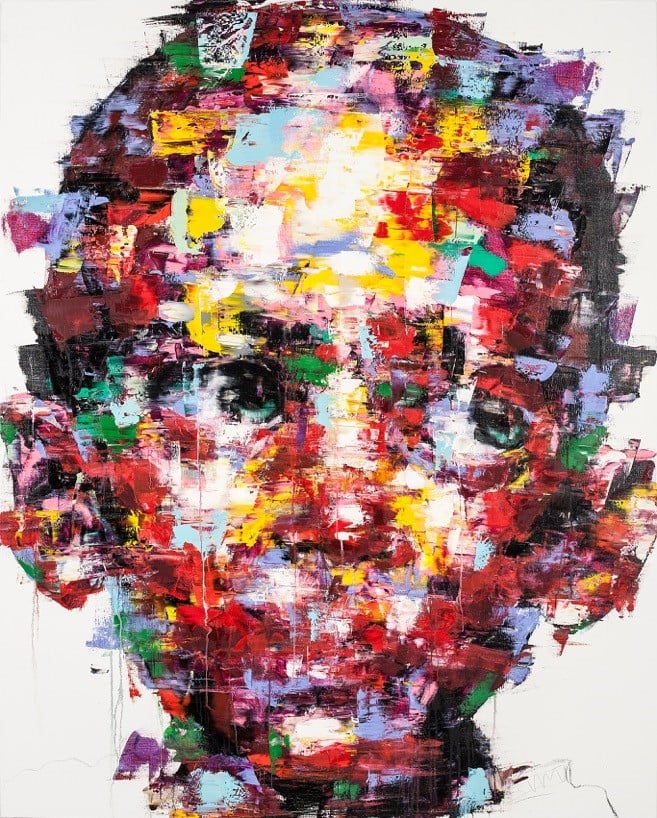On View
artnet Asks: KwangHo Shin and Identity Abstraction
Dive deeper into the brightly colored abstractions of the South Korean artist.

Dive deeper into the brightly colored abstractions of the South Korean artist.

Artnet Galleries Team

Often labeled as the “complexity of human emotions,” the work of KwangHo Shin is instantly striking. The vivid abstract portraits that make up his collection are an attempt to express what cannot be expressed by words; to challenge the notion of identity and interactivity between people. By utilizing unique combinations of charcoal, acrylic, and oil paint, Shin creates works ranging from self-portraits to celebrities, all while distorting and exaggerating the image to confront our perception of the human form. We recently sat down with the artist to learn more about his challenges, artistic method, and his thoughts on his current show at the UNIX Gallery, where his emotive works will be exhibited until July 30.
When did you know you wanted to be an artist?
I don’t think there was a precise moment when I realized that I wanted to become an artist. From when I was around 10 years old, I found myself vaguely enjoying making and creating without knowing how the time flew by, and naturally I ended up at an art high school and art school at college. And that “vague enjoyment” has been continuing on now, and I continue to do what I like rather than thinking about what I should become.

Installation view. Courtesy of the UNIX Gallery.
Describe the medley of color and darkness in your work, and what it signifies to you.
I do not put a special meaning on each color, but colors fulfill various roles at the moment of creation. Among those the most important is it’s bridging a connection between myself and the canvas. The blank white canvas and I exchange a story like conversing the moment I put down a color. When I am frantically talking in that way the conversation suddenly ends and the moment comes when I must stop.
In certain pieces you paint very detailed, true to life faces, while in other pieces you create an abstract medley of color. Describe your thought process.
Abstraction is very akin to scientific experimentation. Because there is no determined point of beginning or end it’s very suffocating to limit oneself to a certain form or idea. In order to express human emotions that are difficult to express in words, I try to express using the most versatile visual language. For that reason I do not decide on a particular form or idea when doing work.

A close-up of Shin’s work. Courtesy of the UNIX Gallery.
Would you say that your work speaks to any one group in particular, more than others?
My artistic creation is for myself only.
Who, artist or otherwise, do you admire?
I respect Gerhard Richter, Anselm Kiefer, Lucian Freud, and many other artists.
They say that “the eyes are the window to the soul.” Comment on your depiction of the subject’s eyes in your work.
I think I hear that question about the eyes very often. That means that people consider the eyes as something very important, and everyone thinks a special meaning is embedded in them. I do not want to further insert my own thought into this issue and reduce the ability of the audience to perceive as well as life force within my work.
What has been your greatest challenge so far?
All South Korean men who are in their 20s must go to the military. At that time, I was in the frontline GOP brigade. Every brigade must be different, but I experienced the most difficult situations that were demanding to the body and mind. Those were precious experiences that made me look back at my life one more time, but I do not want to ever go back there again.

Shin’s studio. Courtesy of the UNIX Gallery.
How do you feel your work is viewed in Korea, versus in other cities around the world?
I think I am getting a positive response from all the young people around the world. However, people who are more advanced in age, who are able to buy my work, feel unfamiliar and intimidated by my works.
Talk about your current exhibition with UNIX Gallery, “제목이 없는 존재.” Do you have a vision for your future?
Most of us live with a name or a title. Although there might be cultural differences, we have that name through various languages of emotions, or ecstasy, sadness, happiness, and frustration. However, I think that it’s impossible to include all the complicated and subtle emotions through words only. I propose to express these different emotions that are hard to explain through my artistic visual language. It’s possible to say that this process is a process of searching the essence of the being called ‘me.’
My dream as of now is to become a happy person. I do not plan about my future. There is nothing that happens under my plan anyways (who knew that I would be working and exhibiting in NYC at this young age?). Planning is akin to self-consolation or refuge about the uncertain future.
If you could have dinner with one person, alive or dead, who would you chose?
My parents.

KwangHo Shin, Untitled 16NY43 (2016). Courtesy of the UNIX Gallery.